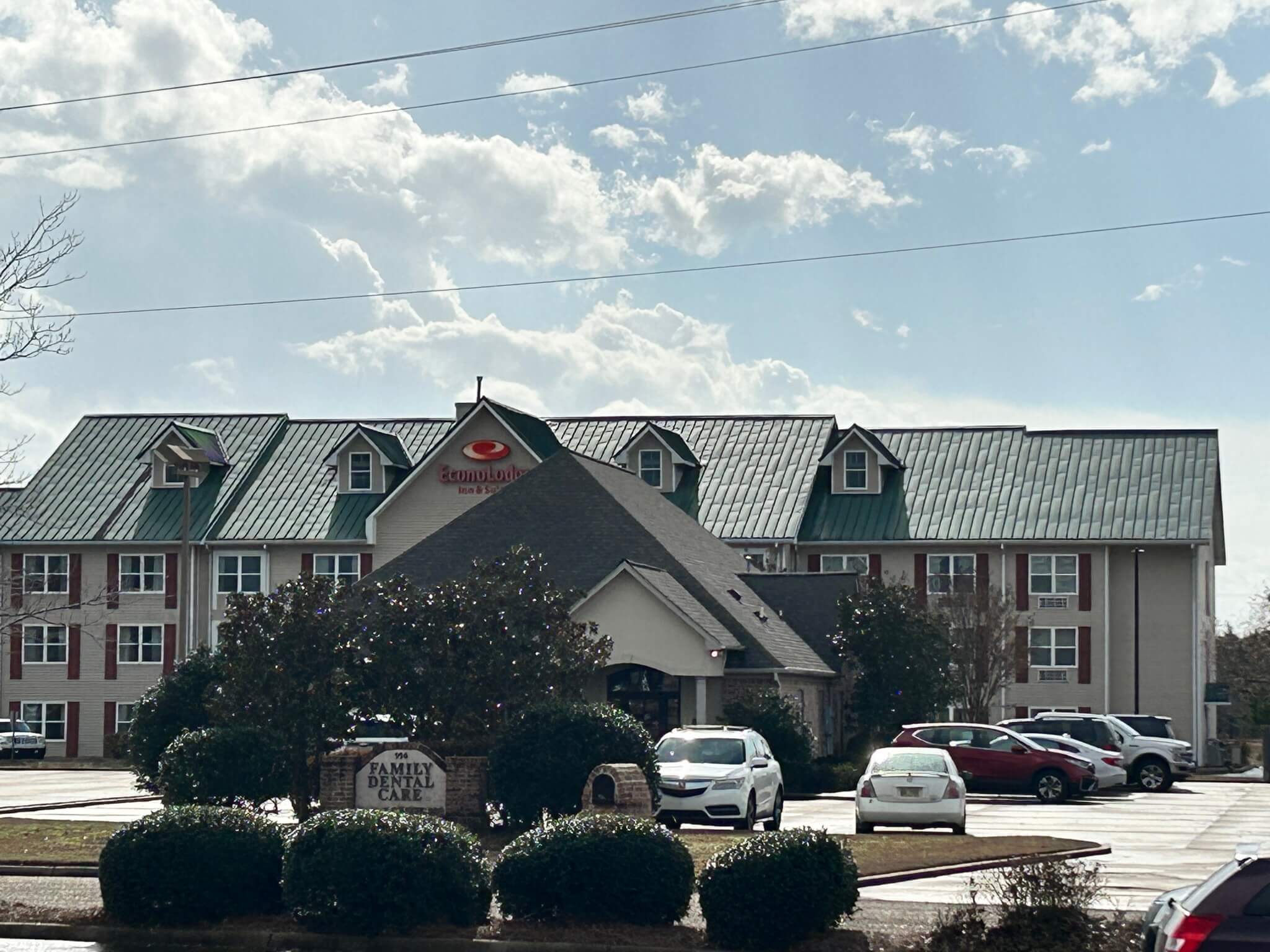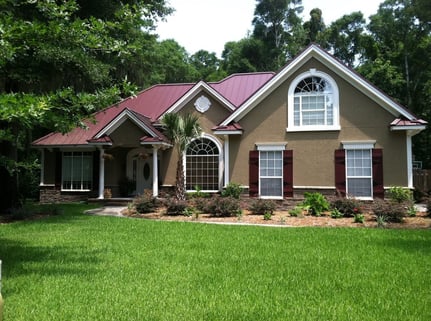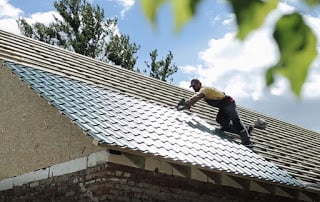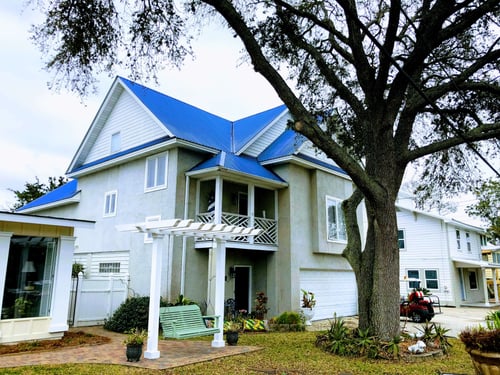
Customizing the outside of your home is a fun way to show off your personal style without anyone even seeing you! While some prefer a rustic look with rich, dark woods and a cozy atmosphere, others are keener on metal's firm and sleek appearance.
If you're someone who enjoys the durability and longevity of a metal roof, you have great taste because they're one of the best options available. With any roof choice, however, there are potential drawbacks that can show themselves over time. For metal roofing, oil canning is one of them. While you aren't necessarily guaranteed to have a significant issue with it down the line, it's essential to know that all metal "oil cans" eventually. Certain metals are more prone to it, as well.
If this news isn't settling well at the moment, don't worry- we'll explain all you need to know here! RoofCrafters has repaired and replaced metal roofing systems for almost thirty years. We know that oil canning can leave homeowners with questions like, "Will this affect how long my roof lasts?" and so many more.
This article is your all-you-need-to-know guide on what oil canning is, how to reduce the chances of it happening to you, and how it's fixed. Metal roof options are stunning and long-lasting regardless of potential oil canning, but it's essential to know more about it as a homeowner with this type of roofing installed. By the time you finish reading, you'll be a semi-pro on the basics of oil canning, which will help you make more informed decisions as a homeowner. Are you ready to begin?
What is Oil Canning?
Oil canning is a naturally occurring phenomenon that affects every type of metal. Any metal roof has the potential to face this problem eventually, and it won't put a strain on your roof in any way besides visually.
Oil canning is a distortion of the aesthetic of the metal and often looks wavy. This phenomenon affects cold-rolled metal products and can be seen on the flat areas of the roof. It's considered a moderate issue in regard to looks but a minor issue in the realm of functionality. The wavy, rippling movements are easily identifiable on the broad areas of the metal roof wall. Oil canning can occur on any metal, no matter how expensive, including:
- Aluminum
- Zinc
- Steel
- Copper
Because metal has a highlighted, reflective surface, the colors you choose and materials you put on it can either reduce the appearance of oil canning or make it more profound. Even small details, like looking at the roof from a certain angle or in sunlight, can make the waves show their imperfections more visibly.

Metal roofs are long-lasting and perfect for a wide array of homeowners, so the idea of oil canning can put a damper on the mood of someone considering this option. While that's perfectly understandable, it's critical to know that there are ways to reduce the look of oil canning on your metal roof!
Which Metal Roof Types Are Prone to Oil Canning?
As mentioned, oil canning can appear on any type of metal roof. According to many contractors who have worked closely with metal roofs, however, aluminum seems to be one of the most susceptible. Standing seam roofing systems can also highlight oil canning a little more than other types because of their flat, smooth, open surfaces that easily reflect light.
Flat Panel
Flat Panel roofing types show major oil canning. While they are free of interior ribs and undulations, they are at the most significant risk for the oil canning phenomenon. Using a backer rod under the panels can help reduce the look of oil canning, so that's something to remember when talking to your roofer. Your roofing professional may also have other suggestions for tackling this problem, so ensure you ask about them.

Mini Ribs Panel
This type of metal panel has a few more advantages when it comes to oil canning. Their stiffened ribs help keep oil canning at bay while giving the panel a dimensional look, which is also helpful. The ribs also help strengthen the panel itself! Some options are a square or rounded rib design and a double or quad panel. They do not completely keep oil canning away, though.

Striated Panel
Striation is the way to go if you want to stay far away from oil canning. While it still happens, it shows much less than with the other two panel types. Because of its ridges, oil canning is more camouflaged. This panel also has other advantages, like offering better curb appeal and being more durable than the others. It even reduces glare and diffuses light!
Factors that Increase Oil Canning Visibility
There are a few factors that can directly affect how major oil canning is. Improper installation is the most significant contributor, so ensure you choose a certified roofer who knows what they're doing. The following are issues that will make oil canning show more on your roof:
- Overtightening of panels and fasteners
- Installation over uneven roof decking
- Improper panel storage and handling
- Thermal expansion and contraction

Is Metal Roofing Right for Me?
Even though oil canning is inevitable on most metal roofs, they're still a fabulous option for many homeowners. Remember- oil canning won't affect how long your metal roof lasts; it'll just give it a different appearance. Every roof type has its drawbacks, and this is one of very few when it comes to metal roofing systems.
If you're ready to gear up for a new metal roof or have questions/concerns about your current one, there are professional roofers who are more than excited to walk with you as you navigate through the process! Not all roofers are going to give you the best experience out there, though, so ensure you do as much research as possible. With a little time and digging, you'll find a roofer that can give you the roof of your dreams.
Okay, so you're an unofficial semi-pro on oil canning now, but you may want to learn a bit more. Check out our learning center to read up on metal roofing and what to expect with it. There's enough information for everyone! And once you've decided you're ready to get in touch with a roofer, check out our comprehensive checklist to determine what you should look out for before your next roofing project. To get in touch with one of our astounding RoofCrafters representatives, head over to our contact page.
My name is Kevin Mills, and I am the lead estimator for RoofCrafters’ Tampa division. I’m originally from Michigan, and I enjoy hunting, fishing, and spending any free time outdoors. What I’m most passionate about, though, is helping business owners and homeowners alike achieve their roofing goals, all while providing a seamless customer journey.






